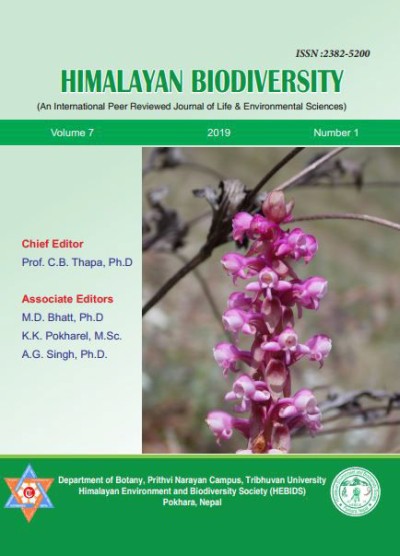A Study on the Medicinal Chemistry of Curcuma Longa
DOI:
https://doi.org/10.3126/hebids.v7i1.40188Keywords:
Cucuma, medicinal chemistry, phytochemistry, traditional medicineAbstract
Plants are the major source of drug in the modern as well as traditional system of medicine throughout the world. Curcuma longa belonging to the family Zingiberaceae, is a medicinally important perennial herb distributed throughout the tropical and subtropical regions of the world from sea level to 1200 m. Therapeutically, C. longa has been used for curing various diseases such as asthma, anemia, chronic bronchitis, fever, dysentery, cough, diabetes, diarrhea, eye disease, hepatitis, hysteria, indigestion, itching, leprosy, liver disorder, menstrual disorder, peptic ulcer, small pox, chicken pox, tonsillitis, urinary infection etc. The objective of the study was phytochemical screening of C. longa for highlighting the traditional uses and pharmacological properties of its rhizomes. The rhizomes were collected from Pokhara Metropolitan -3, Nadipur, Nepal in November 2019. The collected rhizomes were washed thoroughly, cut into pieces, shaded dried completely, grinded into fine powder, extracted by Soxhlet extractor, evaporated the extract to get dark orange residue. Phytochemical screening was conducted by using standard methods. Phytochemical analysis of methanolic and ethanolic rhizome extract of C. longa showed that it contained alkaloids, steroids, tannins, flavonoids, carbohydrates, cardiaic, glycosides, phytosterol, anthocyanin, emodins, diterpenes, leuco anthocyanin, anthroquinone, chalcones, phenols, coumarin and phlobatannin in methanolic extract but not in ethanolic. Previous pharmacological studies on C. longa showed that it possessed antiviral, antifungal, anticancer, antidepresent, antimalarial, antimicrobial, antioxidant, antiplatelet, antibacterial, antivenum, antimutagenic and anticarcenogenic activities. Further phytochemical analysis using solvents of different polarity is necessary to identify much more phytochemical constituents for highlighting pharmacological and traditional medicinal properties.
Downloads
Downloads
Published
How to Cite
Issue
Section
License
© Himalayan Environment and Biodiversity Society (HEBIDS)

